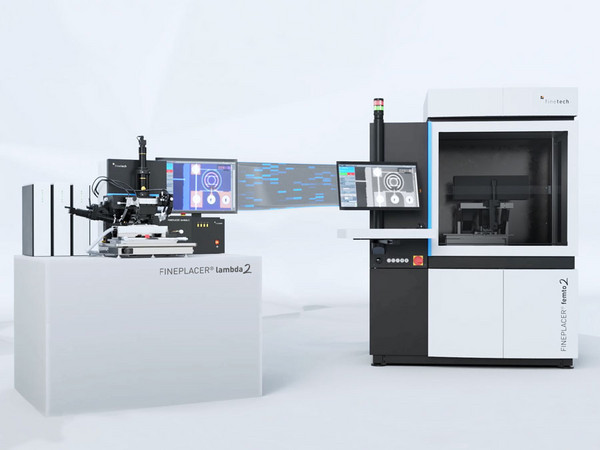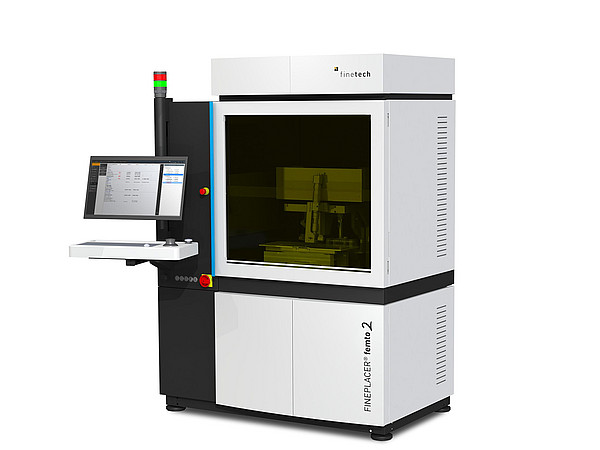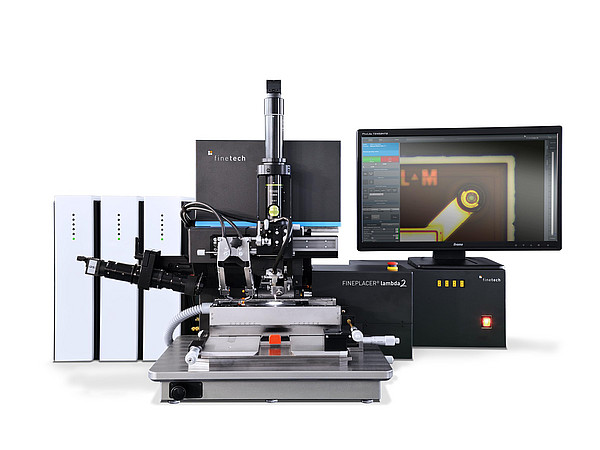Ultra Communications designs, develops and manufactures the industry’s most compact, high-speed fiber optic components for harsh environments (HEFO). For the development and production of a particularly resilient transceiver module, Ultra Communications sought out Finetech’s high precision bonding equipment, as well as the company’s experience with complex opto-electronics assembly.
Today, large amounts of data are predominantly transferred via fiber optical cables, usually made from glass fiber. Advantages in comparison to regular copper lines are low-loss, long-haul signal transmission, significantly reduced energy costs, as well as impassivity against electromagnetic disturbances. On both ends of the fiber optical cable are transceiver modules with separate transmitter and receiver units. Optical transceiver receivers use an O/E converter to convert optical signals coming through the glass fiber into electric signals. Receiver detectors are typically light-sensitive components such as superfast photo diodes. On the transmitting end, E/O converters convert the electric signal to optical signals and send them into the optical glass fiber.
Worldwide, there is huge demand in modern data infrastructure. Therefore, many companies from the opto-electronics sector are undergoing steps to invest in the development and production of increasingly powerful transceiver units. Ultra Communications is one of them, but they go one step further. Their robust transceivers are used in rugged environments wherever large amounts of data needs to be transferred fast and interference-free in difficult conditions – aerospace, advanced vehicles, ships or in high performance computing. To function properly, they need to resist extreme temperatures as well as mechanical shocks, vibrations, condensation, chemical influences or enormous radiation.
Sequential Flip Chip Assembly
The X80 –Q Fury is a full duplex, 40G high performance transceiver for parallel optical data transmission. The prototype series was developed and assembled on a manual die bonder system.
In a very confined space, the module comprises the transceiver IC, a GaAs VCSEL array, a GaAs PIN photo diode array, a lens array and a wave guide board. During a sequential flip chip assembly process, the components are precisely aligned, placed and bonded one by one or as array. The requested post bond accuracy is 1 micron.
Unlike common transceivers with the components glued on, the X80 –Q Fury has them joined by eutectic soldering or thermocompression bonding for very stable connections. In an additional refinement step, all components are underfilled with epoxy and the entire transceiver module is hermetically sealed and lapped.
The manual assembly of a few dozen transceiver modules takes several days due to extensive qualification tests. After each assembly process step, the result of the alignment and bonding is validated in order to guarantee the requested performance and reliability of the final product. Since the modules have numerous bonds (some thermocompression and some UV cure), the tolerance stack of multiple bonds is very complex and not an easy task. In other words, the tolerance stack of each process must be achievable. Building such a product is quite complicated.
“The FINEPLACER® femto 2 has enabled our company to realize higher throughput automation of our high accuracy flip chip bonding operations. As our high reliability opto-electronic transceiver business is expanding, this has helped us to satisfy our customer’s growing needs.”

Director of Manufacturing, Ultra Communications, Inc.
Automation enables true series production
Ultra Communications was challenged when they needed to transition this complex application into automated series production. Due to the positive cooperation during the development stage, it was a logical step for them to continue the journey with Finetech – working with both the US engineering team and experts at the factory. Automating the assembly process enabled reproducible processes while decreasing production costs, thus establishing the prerequisites for true volume production.
It proved very beneficial that profiles certified during manual prototyping (such as parameters for soldering temperature, touch-down force or time) can be easily transferred to Finetech’s automated bonding systems. To automate the assembly process, the profiles simply needed to be enhanced with automatic handling steps for components and sub-assemblies, as well as with automatic alignment routines based on pattern recognition.
The transceivers are assembled in batches of 100 pieces. Tests and qualifications can be done directly at the machine and can be integrated as intermediate steps in the process sequence. Additionally, all sub-processes are automatically protocolled and fed into a production database in real time.






